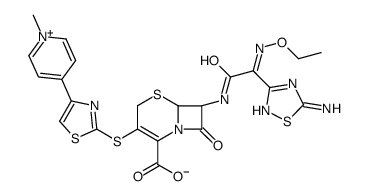189345-04-8
| Name | ceftaroline |
|---|---|
| Synonyms |
UNII-H36Z0FHR8K
(6R,7R)-7-{[(2Z)-2-(5-amino-1,2,4-thiadiazol-3-yl)-2-(ethoxyimino)acetyl]amino}-3-{[4-(1-methylpyridinium-4-yl)-1,3-thiazol-2-yl]sulfanyl}-8-oxo-5-thia-1-azabicyclo[4.2.0]oct-2-ene-2-carboxylate (6R,7R)-7-[[(2Z)-2-(5-amino-1,2,4-thiadiazol-3-yl)-2-ethoxyiminoacetyl]amino]-3-[[4-(1-methylpyridin-1-ium-4-yl)-1,3-thiazol-2-yl]sulfanyl]-8-oxo-5-thia-1-azabicyclo[4.2.0]oct-2-ene-2-carboxylate Pyridinium,4-(2-(((6R,7R)-7-(((2Z)-2-(5-amino-1,2,4-thiadiazol-3-yl)-2-(ethoxyimino)-1-oxoethyl)amino)-2-carboxy-8-oxo-5-thia-1-azabicyclo(4.2.0)oct-2-en-3-yl)thio)-4-thiazolyl)-1-methyl-,inner salt PPI 0903M |
| Description | T-91825 (PPI-0903M), an N-phosphono-type cephalosporin, is the active form of TAK-599. T-91825 is active against both gram-positive and gram-negative bacteria[1][2]. |
|---|---|
| Related Catalog | |
| In Vitro | PPI-0903M is very active against S. aureus (MIC50=0.25 μg/mL), including methicillin-resistant (MRSA) strains (MIC50=1 μg/mL)[1]. PPI-0903M is active against hetero-vancomycin-intermediate S. aureus (100 strains), with MIC50s ranging from 0.25 to 4 μg/mL[1]. |
| In Vivo | AK-599 (20 mg/kg; s.c. three times a day for 2 days) decreases the bacterial cell counts in lungs more than 99.9% in a mouse pneumonia model caused by MRSA[2]. |
| References |
| Molecular Formula | C22H20N8O5S4 |
|---|---|
| Molecular Weight | 604.70500 |
| Exact Mass | 604.04400 |
| PSA | 291.00000 |
| LogP | 0.67090 |
